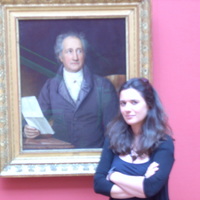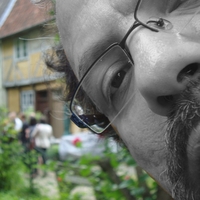Books by Jonathan Wipplinger

The Jazz Republic examines jazz music and the jazz artists who shaped
Germany's exposure to this ... more The Jazz Republic examines jazz music and the jazz artists who shaped
Germany's exposure to this African American art form from 1919 through
1933. Jonathan O. Wipplinger explores the history of jazz in Germany as
well as the roles that music, race (especially Blackness), and America
played in German culture and follows the debate over jazz through the
fourteen years of Germany's first democracy. He explores visiting jazz
musicians including the African American Sam Wooding and the white
American Paul Whiteman and how their performances were received
by German critics and artists. The Jazz Republic also engages with the
meaning of jazz in debates over changing gender norms and jazz's
status between paradigms of high and low culture. By looking at German
translations of Langston Hughes's poetry, as well as Theodor W. Adorno's
controversial rejection of jazz in light of racial persecution, Wipplinger
examines how jazz came to be part of German cultural production more
broadly in both the US and Germany, in the early 1930s.
Using a wide array of sources from newspapers, modernist and popular
journals, as well as items from the music press, this work intervenes
in the debate over the German encounter with jazz by arguing that the
music was no mere "symbol" of Weimar's modernism and modernity.
Rather than reflecting intra-German and/or European debates, it suggests
that jazz and its practitioners, African American, white American, Afro-European, German and otherwise, shaped Weimar culture in a central
way.
Papers by Jonathan Wipplinger
The Jazz Republic
The Jazz Republic, 2017
Singing Like Germans: Black Musicians in the Lands of Bach, Beethoven, and Brahms.By Kira Thurman. Ithaca, NY: Cornell University Press, 2021. 368 pages+30 b/w images. $32.95 hardcover, $15.99 e-book
Monatshefte
Weimars Wirkung. Das Nachleben der ersten deutschen Republik ed. by Hanno Hochmuth, Martin Sabrow, and Tilmann Siebenreichner
German Studies Review, Oct 1, 2022

University of Michigan Press, 2017
And now I have to tell you how it was back then, when the world, pretty much reaching its goal on... more And now I have to tell you how it was back then, when the world, pretty much reaching its goal on the first try, had become jazz.-Hans Janowitz Contents Acknowledgments ix This project has accompanied me now for more than ten years and across four institutions. Over this period, I have had more opportunities than I can recount to converse with scholars and colleagues about the subject of jazz music and popular culture in Germany during the 1920s. Their cumulative effect has helped shape The Jazz Republic. Even more so, without the collective support, guidance, and knowledge of friends and colleagues, The Jazz Republic simply would not have been completed. Throughout, I've also been financially supported through a number of grants and stipends from the University of Michigan, North Carolina State University, and the University of Wisconsin-Milwaukee. At both my current and previous institutions, senior colleagues in German have supported me to a degree that went far beyond the call of duty. Fittingly, they each share the first name "Ruth." At North Carolina State, Ruth Gross was my department chair, a scholarly mentor, and simply a wonderful colleague. At Milwaukee, I have had the luck to be helped along and quite often lifted up by Ruth Schwertfeger: our conservations always left me with a smile on my face. I cannot thank each of them enough. The following is an attempt to list, in no particular order other than alphabetical, some of those who have contributed to the current work over the years.

Eccentric Modernism, Or: George Grosz’s Gramophone Goes Meschugge
Colloquia Germanica, 2016
Colloquia Germanica 46.4 (2013), 366-388. This article seeks to provide an outline of the eccentr... more Colloquia Germanica 46.4 (2013), 366-388. This article seeks to provide an outline of the eccentric modernism of early twentieth-century German popular culture. Framed by textual and aural encounters between the Dadaist Georg Grosz and the Berlin popular musician known as Mr. Meschugge, it sketches out German popular musical culture circa 1910 through discussion of musicians, spaces of musical production such as music cafés, as well as sound recordings and their associated technologies. Using historical documents from the period as well as later reminiscences, it argues that the emergence of German “eccentric bandleaders” (Kapellmeister) like Mr. Meschugge are part of a broader fascination and experimentation with the idea and embodiment of the “eccentric.” In other words, it argues that musicians like Mr. Meschugge are representative of an alternative form of modernism: “eccentric modernism.” In addition, the article uses the reconstruction of this forgotten musical type and culture to cast new light on the relationship of German popular musical culture not only to modernist movements like Dada, but also to networks of musical exchange in the Atlantic world.
A People’s Music: Jazz in East Germany, 1945–1990
German History, 2021
»Ich schnitt in seine Rinde so manches liebe Wort« Liebe zum Grammophon und grammophonische Liebe bei Thomas Mann
Thomas Mann, 2012

Journal of American Studies, 2017
This study argues that the works of seemingly disparate authors such as Vladimir Mayakovsky and L... more This study argues that the works of seemingly disparate authors such as Vladimir Mayakovsky and Langston Hughes are representative of what Lee calls the ethnic avant-garde. Works by this group are distinguished not only by politics, but also by an aesthetic sensibility marked by the ability "to see both the political vanguard and artistic avant-garde as compatible with the past and descent" (). In other words, ethnic modernists do not follow the historical avant-garde's radical break with the past, and in this, Lee argues, they were allied with the Soviet avant-garde. The organizing metaphor in Lee's account of Moscow's aesthetic and political attraction to modernists from non-European, underrepresented, and oppressed groups is Vladimir Tatlin's Monument to the Third International (). Its two spirals, "which chase each other but never touch," parallel the relationship between the political and aesthetic promise of Moscow as "the alignment of two internationalsthe Communist international and international avant-garde" (). Further, as a work combining premodern, modern, and universal elements, Tatlin's tower is suggestive of the idea of "Moscow and the revolution as uncannily inclusive, as promoting not only class-based equality but also unexpected cross-cultural encounters" (). The book itself consists of an introduction, followed by four substantive chapters and an afterword. Paralleling the nonlinear method of the authors under consideration, the individual chapters do not follow a strict chronology, but rather circle back and cycle through a series of encounters between the Soviet and ethnic avantgarde. Chapter explores questions of translation and mistranslation in Vladimir Mayakovsky. In poetic works Mayakovsky produced during his travels to Cuba, Mexico, and the United States, Lee sees a model, albeit an imperfect one, of "embracing the non-Western Other without relegating her or him" (). The chapter closes with an analysis of translations of these works by Langston Hughes, showing how the African American poet "builds upon rather than counters Mayakowsky" (). Chapter looks at Sergei Tret′iakov's trip to China and his play Roar China, a critique of British imperialism based on the violent repression of an entire town following the death of an American businessman. Tracking Roar China's production history, from its Moscow premiere through appearances on Broadway and in Guangzhou, allows Lee to flesh out how the play's layering of temporalities and fragmented structure functioned in different national, linguistic, and political contexts. Chapter three turns back to Langston Hughes and his participation in the ill-fated Soviet film about African American history, Black and White, begun in . Lee interrogates Hughes's later critique of the film as inauthentic through an analysis of the original script written by Georgii Eduadovich Grebner. Though by no means without its flaws, for Lee the script was "far from the 'ludicrousness' described by Hughes" and drew inspiration from treatments of African Americans in the US leftist press (). According to Lee and pace Hughes, the film was put on hold not because of script difficulties (later to become the official Soviet party line), but on account of Moscow's desire to better its working relationship with Washington.

Performing Race in Ernst Krenek’s Jonny spielt auf
University of Illinois Press, 2017
This chapter examines the role of race and racial representation in Ernst Krenek's 1927 opera... more This chapter examines the role of race and racial representation in Ernst Krenek's 1927 opera Jonny spielt auf (“Jonny Strikes Up”) in order to determine whether it can be considered a work that is deeply concerned with jazz, African Americans, and their image within European culture. Jonny spielt auf is a combination of European modernism, American popular music, and what Krenek took to be jazz. However, Krenek resisted the notion that his was a “jazz opera,” a term often applied to the opera during the Weimar Republic. This chapter explores how Jonny's musical, cultural, and racial identities are constructed in the opera by focusing on race and racial stereotypes embedded within the score and libretto. It shows how contradictory and competing ideas about African Americans and their music converge in Jonny spielt auf. It also highlights multiple strands of Jonny's identity, between blackface and blackness, that it argues are never entirely reconciled in the opera.

The Racial Ruse: On Blackness and Blackface Comedy in fin-de-siècle Germany
The German Quarterly, 2011
This article explores the role of blackface minstrelsy within German culture at the turn of the t... more This article explores the role of blackface minstrelsy within German culture at the turn of the twentieth century. I argue that blackface's presence in the colonial and global world of the fin de siecle had the effect of forcing a reevaluation and reinterpretation of the very notion of what it meant to be German in modernity. I trace the construction of blackface as a racial ruse within a discursive nexus of psychology, comic theory, and mass culture. After developing a theoretical model for the German reception of blackface, I discuss the function of blackness and blackface within comic theory, in particular the writings of Theodor Lipps and Emile Kraepelin. I then look at how blackness and blackface “comedy” were taken up in the literary realm by Oskar Panizza, whose texts of the 1890s elevate race and racial masquerade to essential components of modern culture. Finally, I conclude by suggesting some ways in which my reading of blackface remains relevant for thinking about race and blackness in Germany today.
Classical Music in Weimar Germany: Culture and Politics before the Third Reich by Brendan Fay
German Studies Review, 2020
The Return of Jazz: Joachim-Ernst Berendt and West German Cultural Change. New York and Oxford: Berghahn Books, 2009
... Anti-Festival/Total Music Meeting: A festival devoted to more avant-garde forms of jazz and f... more ... Anti-Festival/Total Music Meeting: A festival devoted to more avant-garde forms of jazz and free music, timed to coincide with the official Berlin Jazz Days. First held as anAnti-Festival in 1968. Soon after re-titled as the Total Music Meeting. ...

Colloquia Germanica 46.4 (2013), 366-388.
This article seeks to provide an outline of the eccentr... more Colloquia Germanica 46.4 (2013), 366-388.
This article seeks to provide an outline of the eccentric modernism of early twentieth-century German popular culture. Framed by textual and aural encounters between the Dadaist Georg Grosz and the Berlin popular musician known as Mr. Meschugge, it sketches out German popular musical culture circa 1910 through discussion of musicians, spaces of musical production such as music cafés, as well as sound recordings and their associated technologies. Using historical documents from the period as well as later reminiscences, it argues that the emergence of German “eccentric bandleaders” (Kapellmeister) like Mr. Meschugge are part of a broader fascination and experimentation with the idea and embodiment of the “eccentric.” In other words, it argues that musicians like Mr. Meschugge are representative of an alternative form of modernism: “eccentric modernism.” In addition, the article uses the reconstruction of this forgotten musical type and culture to cast new light on the relationship of German popular musical culture not only to modernist movements like Dada, but also to networks of musical exchange in the Atlantic world.
“Germany, 1923: Alain Locke, Claude McKay and the New Negro in Germany.”
Callaloo, 2013
“‘Ich schnitt in seine Rinde so manches liebe Wort.’ Liebe zum Grammophon und grammophonische Liebe bei Thomas Mann.”
Thomas Mann. Neue kulturwissenschaftliche Lektüren, 2012
“Performing Race in Ernst Krenek’s Jonny spielt auf.”
Blackness in Opera, 2012

“The Racial Ruse: On Blackness and Blackface Comedy in fin-de-siècle Germany.”
German Quarterly, 2011
This article explores the role of blackface minstrelsy within German culture at the turn of the t... more This article explores the role of blackface minstrelsy within German culture at the turn of the twentieth century. I argue that blackface's presence in the colonial and global world of the fin de siècle had the effect of forcing a reevaluation and reinterpretation of the very notion of what it meant to be German in modernity. I trace the construction of blackface as a racial ruse within a discursive nexus of psychology, comic theory, and mass culture. After developing a theoretical model for the German reception of blackface, I discuss the function of blackness and blackface within comic theory, in particular the writings of Theodor Lipps and Emile Kraepelin. I then look at how blackness and blackface “comedy” were taken up in the literary realm by Oskar Panizza, whose texts of the 1890s elevate race and racial masquerade to essential components of modern culture. Finally, I conclude by suggesting some ways in which my reading of blackface remains relevant for thinking about race and blackness in Germany today.










Uploads
Books by Jonathan Wipplinger
Germany's exposure to this African American art form from 1919 through
1933. Jonathan O. Wipplinger explores the history of jazz in Germany as
well as the roles that music, race (especially Blackness), and America
played in German culture and follows the debate over jazz through the
fourteen years of Germany's first democracy. He explores visiting jazz
musicians including the African American Sam Wooding and the white
American Paul Whiteman and how their performances were received
by German critics and artists. The Jazz Republic also engages with the
meaning of jazz in debates over changing gender norms and jazz's
status between paradigms of high and low culture. By looking at German
translations of Langston Hughes's poetry, as well as Theodor W. Adorno's
controversial rejection of jazz in light of racial persecution, Wipplinger
examines how jazz came to be part of German cultural production more
broadly in both the US and Germany, in the early 1930s.
Using a wide array of sources from newspapers, modernist and popular
journals, as well as items from the music press, this work intervenes
in the debate over the German encounter with jazz by arguing that the
music was no mere "symbol" of Weimar's modernism and modernity.
Rather than reflecting intra-German and/or European debates, it suggests
that jazz and its practitioners, African American, white American, Afro-European, German and otherwise, shaped Weimar culture in a central
way.
Papers by Jonathan Wipplinger
This article seeks to provide an outline of the eccentric modernism of early twentieth-century German popular culture. Framed by textual and aural encounters between the Dadaist Georg Grosz and the Berlin popular musician known as Mr. Meschugge, it sketches out German popular musical culture circa 1910 through discussion of musicians, spaces of musical production such as music cafés, as well as sound recordings and their associated technologies. Using historical documents from the period as well as later reminiscences, it argues that the emergence of German “eccentric bandleaders” (Kapellmeister) like Mr. Meschugge are part of a broader fascination and experimentation with the idea and embodiment of the “eccentric.” In other words, it argues that musicians like Mr. Meschugge are representative of an alternative form of modernism: “eccentric modernism.” In addition, the article uses the reconstruction of this forgotten musical type and culture to cast new light on the relationship of German popular musical culture not only to modernist movements like Dada, but also to networks of musical exchange in the Atlantic world.
Germany's exposure to this African American art form from 1919 through
1933. Jonathan O. Wipplinger explores the history of jazz in Germany as
well as the roles that music, race (especially Blackness), and America
played in German culture and follows the debate over jazz through the
fourteen years of Germany's first democracy. He explores visiting jazz
musicians including the African American Sam Wooding and the white
American Paul Whiteman and how their performances were received
by German critics and artists. The Jazz Republic also engages with the
meaning of jazz in debates over changing gender norms and jazz's
status between paradigms of high and low culture. By looking at German
translations of Langston Hughes's poetry, as well as Theodor W. Adorno's
controversial rejection of jazz in light of racial persecution, Wipplinger
examines how jazz came to be part of German cultural production more
broadly in both the US and Germany, in the early 1930s.
Using a wide array of sources from newspapers, modernist and popular
journals, as well as items from the music press, this work intervenes
in the debate over the German encounter with jazz by arguing that the
music was no mere "symbol" of Weimar's modernism and modernity.
Rather than reflecting intra-German and/or European debates, it suggests
that jazz and its practitioners, African American, white American, Afro-European, German and otherwise, shaped Weimar culture in a central
way.
This article seeks to provide an outline of the eccentric modernism of early twentieth-century German popular culture. Framed by textual and aural encounters between the Dadaist Georg Grosz and the Berlin popular musician known as Mr. Meschugge, it sketches out German popular musical culture circa 1910 through discussion of musicians, spaces of musical production such as music cafés, as well as sound recordings and their associated technologies. Using historical documents from the period as well as later reminiscences, it argues that the emergence of German “eccentric bandleaders” (Kapellmeister) like Mr. Meschugge are part of a broader fascination and experimentation with the idea and embodiment of the “eccentric.” In other words, it argues that musicians like Mr. Meschugge are representative of an alternative form of modernism: “eccentric modernism.” In addition, the article uses the reconstruction of this forgotten musical type and culture to cast new light on the relationship of German popular musical culture not only to modernist movements like Dada, but also to networks of musical exchange in the Atlantic world.